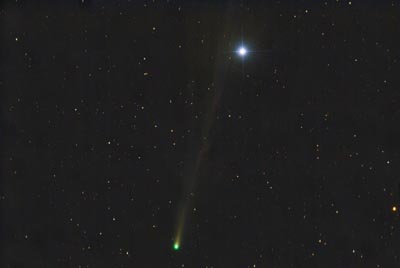ISON and Spica From the
Balcony observing location
November 18, 2013

| There
are times during a full moon when you must get out and do some
imaging. As comet ISON races toward its destiny on the 28th of
November, I can still get it for about half an hour in the east
before the start of morning twilight with the 80mm astrograph
on the balcony. The full moon made for a very deep blue sky and
had to be subtracted out before any real tail was to be seen
in this image. Signal to noise was very low indeed! The comet
has over a full field now of tail, and it shows some bifurcation
and disconnection events. Spica is the brilliant star to the
upper right. The comet was around mag 6 during this session,
and the tail is still ultra faint. With the bright moonlight,
it was certainly not naked eye by any means, and only the head
was faintly seen in binoculars. |  |
ISON - this is a 21 minute total
integration time with the Canon Xti at
ISO 400. Frames were averaged due to
an extremely high background brightness.
Select an image size for a larger view:
1290 x 960
|
 Lens: 80mm f/6 Stellarvue / Zeiss APO with TV.8x FR
Platform: Televue GEM
Exposure: 21m = 21 x 1m
Location: Payson, Arizona
Elevation: 5150 ft.
Sky: Seeing 7/10, Transparency 8/10
Outside Temperature: 40F
Processing Tools: Maxim DL, Photoshop CS2
HOME GALAXIES EMISSION NEBS REFLECTION NEBS COMETS
GLOBULARS OPEN CLUST PLANETARIES LINKS
Lens: 80mm f/6 Stellarvue / Zeiss APO with TV.8x FR
Platform: Televue GEM
Exposure: 21m = 21 x 1m
Location: Payson, Arizona
Elevation: 5150 ft.
Sky: Seeing 7/10, Transparency 8/10
Outside Temperature: 40F
Processing Tools: Maxim DL, Photoshop CS2
HOME GALAXIES EMISSION NEBS REFLECTION NEBS COMETS
GLOBULARS OPEN CLUST PLANETARIES LINKS

|